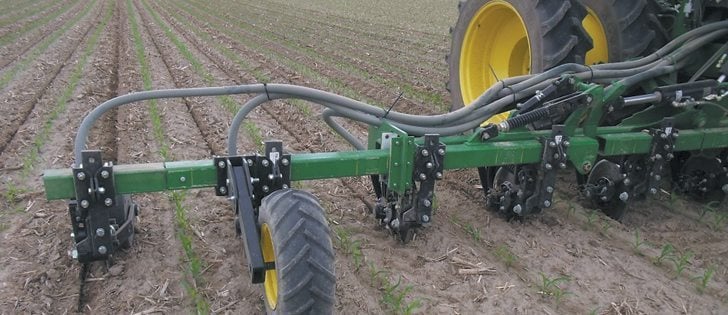Aulari aftermarket attachment | It’s a fit for corn growers looking to use granular fertilizer to improve yields and stay off the juice
Corn growers who want to put granular fertilizer through their planters have been out of luck for two decades.
Planter manufacturers decided in the early 1990s that granular fertilizer was going out of style and that the sector was switching to liquid fertilizer. As a result, they discontinued their granular options.
As one dealership sales manager said recently: “The companies just don’t listen to us dealers. We know what our customers want. They don’t.”
Twenty years later, there are still corn growing regions where liquid fertilizer is a long and expensive truck ride from plant to farmgate, and many growers still want granular.
Read Also

Equipment manufacturing may return to Canada
Some ag equipment and automotive manufacturers are now adjusting their production and distribution to avoid tariff costs in relation to supplying the Canadian market.
There are several reasons for this:
- Typically more acres between fills compared to liquid.
- Dry generally has a lower price.
- Liquid means two complete sets of fertilizer equipment.
“Our air seeders have always been granular,” says Scott Peters of West-Grow Seeds in Boissevain, Man.
“Why would a farmer want to add a complete separate system to handle two kinds of fertilizer? The liquid storage and handling facility represents a major investment, plus you pay more for liquid from that point forward.”
Granular versus liquid will become more of an issue as corn acres expand west and north on the Prairies.
North Dakota grows a lot of corn, but it is not well served with liquid fertilizer.
“I saw a 24-row Case planter in North Dakota that did not have liquid,” Peter said. “It was pulling an Amity or Concord air cart behind the planter.”
Many corn growers in the state run their planters with all kinds of air carts for granular, according to Amity, which is one of the main suppliers of manifolds for this modification. It’s simply a matter of finding the right manifold.
“Our plan is to move from two 16-row planters to a single 24-row planter with granular,” said Peters.
“If the market doesn’t have a convenient way for me to use granular with my planter, then it should be easy to do in the shop.”
Before firing up the welder, Peters said he wants to investigate the Aulari Precision Placement system, which is engineered specifically as a granular retrofit for any brand corn planter.
“I had never heard of Aulari until last year when I was on a Syngenta farm tour in Quebec,” he said.
“This one farmer had an Aulari on his planter. I got a good look at it and decided that’s what I need when I get the 24-row planter.”
Aulari Industries specializes in aftermarket equipment for dry fertilizer on big corn planters. It’s a niche market with only one North American competitor.
The two main products from Aulari are the air tank and the Precision Placement Fertilizer Coulter.
“The big manufacturers don’t want to bother with dry fertilizer on their corn planters anymore,” said Aulari president Patrick Audette.
His company now has a granular system for any brand of corn planter from 12 to 24 rows on any row spacing.
“Growers tell their dealer they want a granular kit on their next planter, and the dealer says no he can’t sell it because he doesn’t have it,” Audette said. “Well, now the dealer can sell the farmer a granular kit we build that’s designed to fit perfectly on his planter.”
He said three major factors are driving the return to granular fertilizer in the corn business: environmental regulations, ground speed and fertilizer prices.
“In the past, fertilizer was broadcast all the time. But now with the regulations coming, we will have to deep-place all fertilizer,” he said.
“With our coulter we can put plenty of fertilizer close to the seed without hurting it. We call it two by two because the fertilizer is two inches to the side and two inches below the seed.
“Most guys put down 350 to 400 pounds product per acre in one pass, or maybe split it into two or three passes. But we have a couple guys who have put down 600 lb. of product in one pass with our system.”
Audette said producers seem to want faster ground speed every spring, and planter designers have no choice but to cater to demands.
“We tell the guys to slow down, but they say, ‘hey, this is 2012 and we have GPS so we can go fast.’ So we design all our equipment to run faster than my father ever let me run with the planter at home.”
He said customers with the 200 bushel tow-between tank and the small 110 bu. frame mount tank plant 260 acres a day in the daylight. That’s 25 percent faster than before they bought the Aulari equipment.
Audette said some of his customers with GPS regularly side-dress corn at 10 m.p.h. without damaging the roots. Those speeds require a lot of down pressure just to keep the openers in the ground. Speed also requires a well-designed coulter to accurately place the fertilizer.
The disc design was the big breakthrough in Aulari’s progress. The first job of the disc each year is precise two by two fertilizer placement while seeding. The second job each summer is side dressing.
With four years on the market, Audette feels the disc design lives up to everyone’s expectations. The gauge wheel had been the glitch in the early stages.
“For us, once we had the gauge wheel right, the accuracy and speed and fertilizer volume were easy,” he said. “We were offering it before through Great Plains. For a few years, we kept asking them to make some changes to improve it. They said, ‘no, why don’t you go and build another disc.’ So that’s what we did. And now we have a better fertilizer opener.”
Audette said the air system can also do double duty because the cart can quickly be switched between a corn planter and a small grains air drill.
“Guys will seed wheat in the morning with a 30-foot drill and our cart, and then switch it over to their planter for corn or soybeans in the afternoon,” he said.
“When it’s time to side dress, the cart is used for everything from wheat to peas to corn. In comparison, I think our air system is closer to Seed Master or Valmar than anything else. It’s built strong and heavy for no-till jobs, but guys say it works well in conventional tillage, too.”
Peters said he has three options once he gets the new planter:
- He can modify an existing air cart to feed a 24-row planter.
- He can buy the Aulari because it’s the only dry kit he’s found with an optional air tank on the planter frame.
- He sourced out only one other dry kit for planters, but the Montag does not have a frame mounted tank. The Montag was featured in the Nov. 1 Western Producer.
The Aulari disc has five depth settings and three settings for down pressure. All settings are manually controlled on the coulter unit.
Discs can be either 18 or 20 inches. The discs run at a seven degree angle. Discs can be quickly replaced by removing the depth pin.
The unit is made of quenched steel. It has tapered, greasable bearings running in a carbon steel hub. Nearly all components are identical left to right. An Aulari granular fertilizer kit to fit any brand of corn planter will cost $160,000 and $170,000.
For more information, contact Audette at 450-792-2126 or visit www.aulari.com.
















